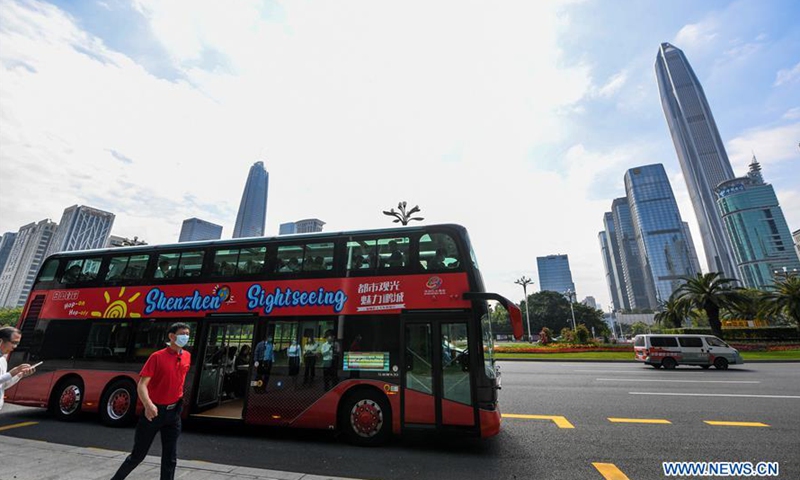SOURCE / INDUSTRIES
Five-year plan to prioritize tech innovation
Self-reliance in key sectors, more international cooperation likely: experts

A sightseeing bus is seen in Shenzhen, south China's Guangdong Province, Oct. 22, 2020. Shenzhen on Thursday launched three sightseeing bus lines for tourists, which respectively showcase the culture, technology and night view of the city. Photo:Xinhua
As the world is paying close attention to how China, the world's second-largest economy, will shape its development plan for the next five years, technological innovation is in the spotlight, as it is a key driver of the "dual circulation" development model.
Marking the first five years of China's new journey toward building a modern socialist country and marching toward the second centenary goal, the 14th Five-Year Plan (2021-25) period is crucial for China to realize key technology targets and play up the role of technology in enhancing the country's high-quality development, experts said.
The broad outlines of the five-year plan are due to be announced after the fifth plenary session of the 19th CPC Central Committee ends on Thursday. The meeting kicked off in Beijing on Monday.
The Ministry of Industry and Information Technology said on Monday that it is actively considering including 5G, integrated circuits, biomedicine and other items into the 14th Five-Year Plan. The ministry will guide enterprises to make breakthroughs in core technology research and innovations.
A report released on Monday by Zhongtai Securities showed that the pace of independent technological innovation should be accelerated in the next stage.
The core technologies of the era may get strong government support during the 14th Five-Year Plan, covering key sectors such as semiconductors, 5G applications, the Internet of Things, and autonomous driving.
China has added plans to bolster the development of the third-generation semiconductor industry in its next Five-Year Plan, a participant in the drafting of the plan previously confirmed to the Global Times.
Unlike second-generation semiconductor technology, which China is now restricted by the US in a wide range of areas from raw materials to production equipment, the next generation of chip technology can be a fresh start and a good opportunity for China to gain the upper hand.
Beyond the hot semiconductor manufacturing, technologies including both hardware and software will strive to make breakthroughs in the next few years since the West also has an advantage in the sector, Li Wei, a senior observer in the high-tech industry, told the Global Times.
As a foundation, localized central processing units and operating systems are where more efforts should be made, said Li.
Ni Guangnan, an academician from the Chinese Academy of Engineering who has also advised the top authority on building "China's system" in confronting competition by the US, is confident in emerging domestic software and hardware, which could replace American technologies in extreme situations.
Even if the US seeks a decoupling from China in the high-tech sector, with the development of "China's system" and chipsets with lower performance that are beyond US export controls, "our IT infrastructure will remain intact" despite the US crackdown, Ni told the Global Times in a recent interview.
"China has been marching steadily forward to become a global technology leader by 2035," said Li.
From the lunar exploration project to the BeiDou navigation satellite system completion with the launch of the system's final satellite, from the roll-off of high-speed maglev trains capable of speeds of 600 kilometers per hour to the world's leading 5G networks, China is keeping pace with more developed Western economies or has even overtaken the latter in some technology domains.
In 2019, the contribution rate of China's scientific and technological progress to economic growth reached 59.5 percent, near the target 60 percent as set during the 13th Five-Year Plan (2016-20).
However, there are still shortfalls in innovation-led technology development that need to be addressed in the next few years, Huang Chengqing, vice president of the Internet Society of China, told the Global Times on Monday.
"We have achieved some tangible results in technology application, but the capability of basic research and development (R&D) still lags behind, and that requires more investment," said Huang.
In terms of engineering and technological research like 5G, enterprises instead of the government should play the major role, and the government should help to create a free and open environment to facilitate R&D, he added.
In the face of a deteriorating external environment in the context of high-tech decoupling, Huang called for strengthened international cooperation instead of isolation.
As innovation blossoms in China, auxiliary measures and policy should keep up with the trend to protect the intellectual property rights of Chinese companies, Huang said, like the recently released export control law, which aims to protect China's national security by regulating exports of sensitive materials and technologies.


